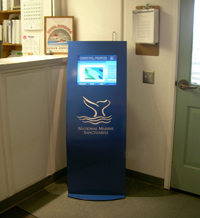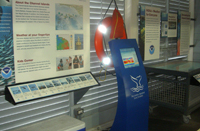New Interactive Touch-Screen Kiosks Offer In-depth Look at NOAA’s Channel Islands Sanctuary
June 26, 2008

High resolution (Credit: NOAA)
Santa Barbara and Ventura County residents and visitors can now explore Channel Islands National Marine Sanctuary without getting their feet wet through new state-of-the-art touch screen NOAA kiosks located at four sites along the coast.
“The new kiosks are a visual and auditory showcase of what the sanctuary has to offer,” said Chris Mobley, superintendent of Channel Islands National Marine Sanctuary. “With the touch of a button, users can learn about marine life and habitats, and get the latest information about our education and outreach programs, research projects and resource protection efforts.”
Developed by the NOAA Office of National Marine Sanctuaries in partnership with NOAA's National Weather Service, the kiosks also provide real-time weather and ocean condition reports and information about the sanctuary’s partners, including museums and visitor centers.

High resolution (Credit: NOAA)
The kiosks have been installed at the California Welcome Center in Oxnard, the Ventura Visitor’s and Convention Bureau, the Ty Warner Sea Center in Santa Barbara, and the Harbor Patrol office at Santa Barbara Harbor. There are existing units at the Santa Barbara Maritime Museum and Channel Islands Harbor. Three more units are slated for installation in early 2009.
For more information, visit the sanctuary's Web site about the kiosk project.
The National Oceanic and Atmospheric Administration, an agency of the U.S. Commerce Department, is dedicated to enhancing economic security and national safety through the prediction and research of weather and climate-related events and information service delivery for transportation, and by providing environmental stewardship of our nation's coastal and marine resources. Through the emerging Global Earth Observation System of Systems (GEOSS), NOAA is working with its federal partners, more than 70 countries and the European Commission to develop a global monitoring network that is as integrated as the planet it observes, predicts and protects.